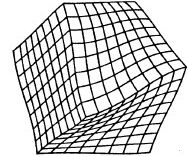 Alamo Creek Engineering
Alamo Creek EngineeringIntroduction to Resonant Ultrasound Spectroscopy
Resonant ultrasound spectroscopy (RUS) is one of the most versatile modulus measurement and nondestructive evaluation techniques available. It is applicable to a wide variety of common materials, high-temperature superconductors and stabilized ceramics, sintered alloys and new electronic materials.The descriptor "resonant ultrasound spectroscopy" (RUS), first coined by Migliori in 1987 is a reflection of the richness of information revealed by the natural modes of vibration, or resonances, of solids. RUS, much like other high-precision modulus measurement methods, is sensitive to both microscopic and macroscopic properties of an object. Elastic moduli, ultrasonic attenuation, and symmetry of materials can all be probed by using RUS.
RUS is qualitatively different from other "ultrasonic" techniques because it is sensitive to all the components of the elastic tensor, "sees" only the true thermodynamic dissipation (a pulse's echo can have its amplitude reduced by dissipation, errors in parallelism of the faces, and transducer bond absorption).
ACE has developed a system that is invaluable to meet the commercial, research and teaching material characterization needs of science, technology and engineering communities.
The system will be of particular interest to: Material suppliers for quality control and certification requirements, fabricators, manufacturers and end users of materials for material properties measurements and input into finite element static and dynamic structural analysis, and design for production, research and prototyping.
ACE Products
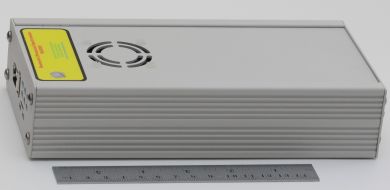
ACE-RUS008
The heart of the design is an ACE-proprietary low-noise charge amplifier, ACE-proprietary isolated output driver, and a microcomputer-based digitizer modified by ACE for RUS performance that provides in-phase and quadrature outputs. Our charge amplifier provides gain and noise levels independent of cable length, important for cryogenic, high temperature, glove-box, production, radiation, and any environment where the transducer stage and electronics package need to be separated.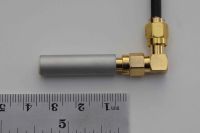
Transducers
ACE has extensive experience in customizing transducers. We can tailor them for size and temperature range, radiation environment, sample size, using any of several connectors, SMA being the largest. All our transducers use electrically-insulating alumina wear plates. This is essential because any metal-contact transducer used with a metallic sample will produce spurious background signals. Ours eliminate this while providing a hard matt surface for extreme durability with no compromise in sensitivity. Internal construction of all ACE transducers use proprietary acoustic damping materials for exceptionally-flat frequency response. Pricing available upon request.
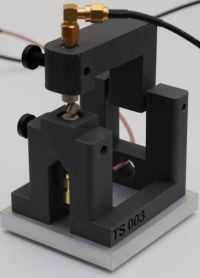
The Stage
Essential to accurate reduction of RUS raw measurements to obtain elastic moduli is that the transducer contact be as light as possible. Our transducers contact the sample in only two places, thereby minimizing any departure from free-surface. Our hinged-arm transducer stage, the result of years of development, is easily adjustable for different sample sizes and always provides the same contact force, enhancing reproducibility not only in a production environment but for research applications as well. It uses a honeycomb internal structure to reduce acoustic transmission through the stage, producing extremely low background.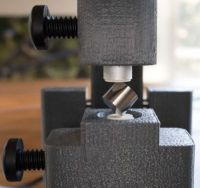
Test Cylinder
A hardened and ground RC 58-60 steel cylinder is provided to verify system setup. The high hardness makes it extremely durable and resistant to damage. It is fabricated with sufficient accuracy that RMS errors on 30 or more resonances will be ca. 0.1%. ACE supplies the cylinder with a certificate of resonances and a fit to elastic moduli obtained with the actual system the customer receives.
Software
There are three components to the supplied software, all easily updatable. They are the micro-SD-card firmware, the data acquisition software, and the data analysis software. The data acquisition software, currently in use at Los Alamos National Laboratory, is a Labview executable so that those familiar with Labview will be right at home with the controls. Detailed instructions are provided. This software produces several outputs, one of which is a text file of resonance frequencies with material-properties header that can be read directly by the data analysis software. The interface is Ethernet so that no additional drivers or hardware are needed for either stand-alone or web-based high-speed operation. It can interface with a number of commercial temperature controllers. There are many features that are implemented based on our decades of measurement experience with RUS. The analysis software is a user-friendly ACE upgrade that includes executables for cylinder and rectangular parallelepiped (RPR) geometry, and detailed instructions on use. The upgrades include an auto-guess feature if moduli are not known, and output in SI units for elastic moduli, engineering moduli, and sound speeds, as well as a quantitative measure of the accuracy of a fit.
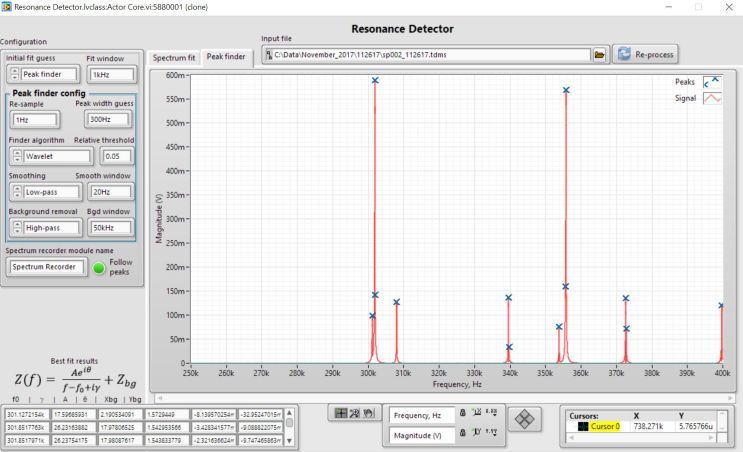
ACE Services
Teaching and Training
Availability of different teaching packages including PDF-based tutorials and a RUS system with a set of standard testing materials. Tailored to your needs, students will use a no-compromise system that will produce results of accuracy equal to the best laboratory measurements on a system that is both affordable and applicable to the science, technology and engineering communities.
We will provide an introduction to RUS and a tutorial on how to acquire and analyze measurements on a selected range of appropriate materials, introduction on how mechanical resonances connect to material properties, Sample preparation, materials compatibility and applicability to RUS, measurements and analysis will all be covered.
Customized workshops can be provided on request.
Each student will have access to a RUS system for the duration of the course.
Characterization
ACE will provide a characterization service to measure test your materials in our own laboratory to meet quality control and certification requirements. We will develop processes tailored to your specific materials.Prices upon request
About Alamo Creek Engineering
Sue Ennaceur - Chief Executive Officer
Sue received her MSc in Chemical Process Technology and PhD in physical chemistry from the University of Durham, UK. She has worked at Davy Process Technology, Stockton-on-Tees in process engineering with applied catalysis and reactor design, business development; legislation; safety and environmental issues. She has worked as scientific officer for Key Forensic Services, a forensic laboratory in the UK where she developed new analytical methods and procedures for a number of inorganic (Gun shot residues, glass and paint) and organic processes (Drugs and explosives). She was also responsible for developing and implementing company Health & Safety policies. Until early 2018, Sue was senior scientist in actinide materials at the atomic weapons establishment (AWE) plc Aldermaston, United Kingdom. There she was a subject matter expert for metallurgical activities on plutonium and other production materials, had the lead role in designing and reviewing metallurgical tests to improve quality and reliability and developed the technical training programme to enhance the skills of process operations staff. She received the SET - JC MARTIN AWARD of 2014 for best external paper. She received numerous silver and bronze awards for process improvements in the Plutonium Technology Centre (2013-2016) and the individual Ministry Of Defence Chief Scientific Award commendation (2013).Albert Migliori - Chief Scientist
Albert Migliori received his B. S. in physics in 1968 from Carnegie Mellon University, his M. S. and Ph.D. in physics from the University of Illinois in 1970 and 1973 and is a leading expert in the use of resonant ultrasound spectroscopy as a solid-state physics tool for which he won in 2016 the Joseph F. Keithley award for advances in measurement sciences from the American Physical Society for the development of Resonant Ultrasound Spectroscopy. He is a fellow of the Los Alamos National Laboratory where he has worked since 1973, the American Physical Society, the American Association for the Advancement of Science, and the Acoustical Society of America. He holds 25 patents.Extensive Expertise
Resonant ultrasound spectroscopic techniques for measurement of the elastic moduli of solids, A. Migliori, J.L. Sarrao, William M. Visscher, T.M. Bell, Ming Lei, Z. Fisk, and R.G. Leisure, Invited Review Article, Physica B 1, 183(1993).On the Normal Modes of Free Vibration of Inhomogeneous and Anisotropic Elastic Objects, W. M. Visscher, A. Migliori, T. M. Bell, and R. A. Reinert, J. Acoust. Soc. Am. 90 2154 (1991).
Resonant Ultrasound Spectroscopy, A. Migliori, J. L. Sarrao, John Wiley, New York, 1997, with chapters on materials science, geophysics, instrument design, and theory.
Implementation of a modern resonant ultrasound spectroscopy system for the measurement of the elastic moduli of small solid specimens. Migliori, A; Maynard, JD Source: Review of Scientific Instruments; Dec. 2005; vol.76, no.12, p.121301-1-7.
Alpha-plutonium's polycrystalline elastic moduli over its full temperature range Migliori, A; Pantea, C; Ledbetter, H; Stroe, I; Betts, JB; Mitchell, JN; Ramos, M; Freibert, F; Dooley, D; Harrington, S; et. al. Source: Journal of the Acoustical Society of America; 2007; v.122, no.4, p.1994-2001
Bounding the pseudogap with a line of phase transitions in YBa2Cu3O6+δ, Arkady Shekhter, B. J. Ramshaw, Ruixing Liang, W. N. Hardy, D. A. Bonn, Fedor F. Balakirev, Ross D. McDonald, Jon B. Betts, Scott C. Riggs & Albert Migliori (2013). Nature 498, 75-77.
Electronics for Resonant Ultrasound. Migliori, A. (2010). The Journal of the Acoustical Society of America 128: 2424.
Materials and Fabrication Techniques for Resonant Ultrasound Spectroscopy at High and Low Temperatures Migliori, A. (2014). The Journal of the Acoustical Society of America 135: 2275.
^Return to the top.